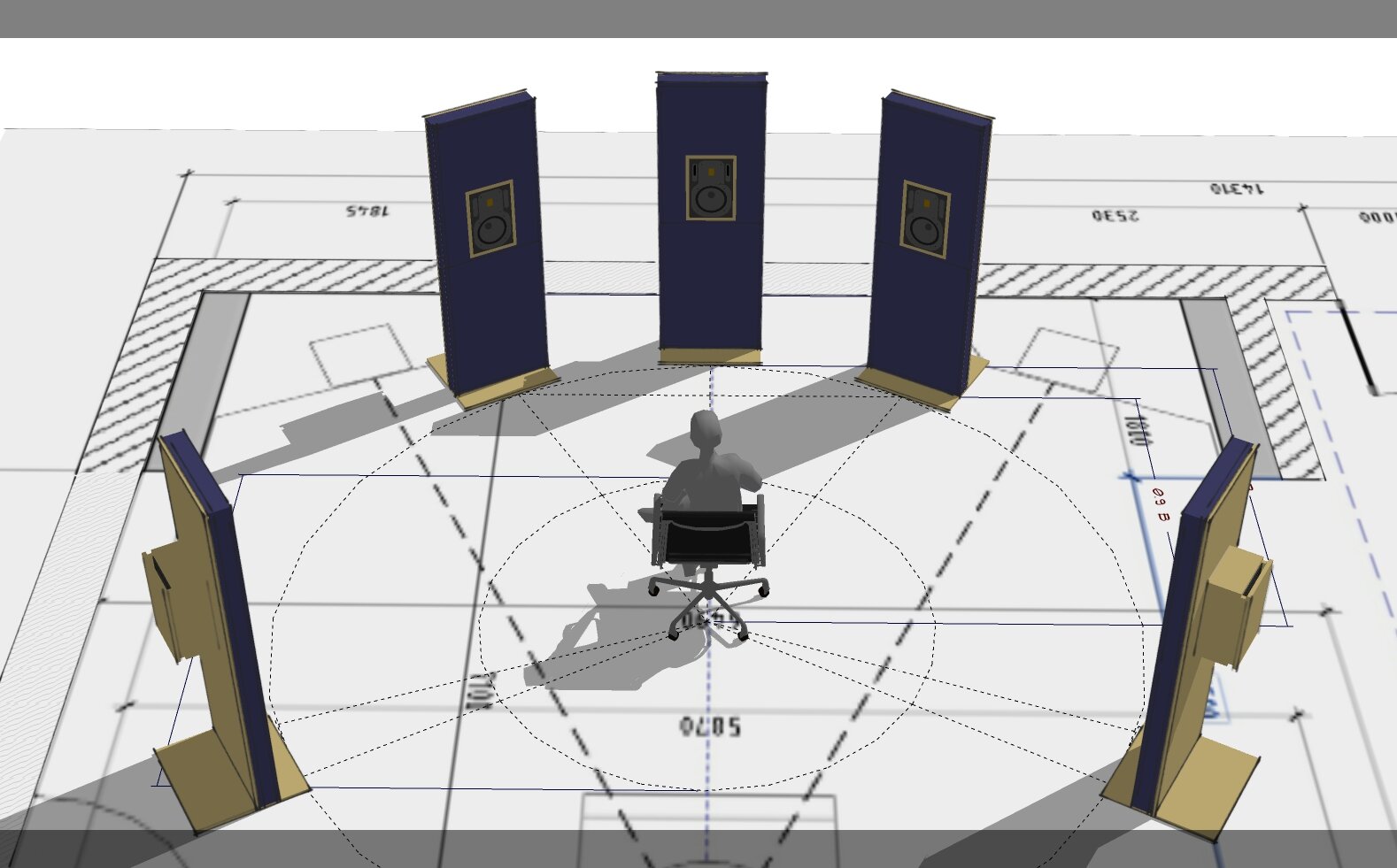-
Posts
1,749 -
Joined
-
Last visited
Everything posted by Glenn Stanton
-
and you know she is...
-
i was playing around with the dearMICRO and AMBIMICRO on a stereo bus and the panning seems to work as a 360 effect although the up/down vertical pan is using EQ to create that. i noticed it's based on the Sennheiser AMBEO tech (which i also have) and all seems ok. on surround 5.1 (even though i'm routing to same two channels on my laptop, my desktop is offline for the moment which does have proper 5.1) the panning seems to behave as i'd expect it via my headphones. in your case, you look like need something to route or simulate a complete 5.1. Waves NX has a 5.1 plugin emulation for headphones (which i've never tried but may have to now) and there dearVR monitor might also. there are several other headphone surround emulating plugins out there as well which may allow you to set up the routing preferences better. https://www.waves.com/nx https://www.waves.com/plugins/nx#introducing-nx-virtual-mix-room (which is what i have)
-
oh, and an Akai S612 with the MD280 disk as the Sampler unit 🙂 back in the days when a real {insert-gender-identity-here} lived for 12-bit audio and slow spiral tracking disk loads 😉 on the plus side, you could sample it live in just as much time as it took to play the 10 second parts and replay it with some cool effects... i liked to use my guitar to form chords and simple leads which then could be played across the keyboard... i recently sold most these as well as a Moog Liberation (Devo), Crumar Performer (Duran Duran), and Sequential Circuits Pro One (which was my bass of choice). Poly800 as pads and leads, DW and DSS as piano, organ, sax, pads, etc. I still keep the Proteus for live performances as it works well with my Keystation-49 (including program changes) (i'm mostly a bass player or rhythm guitar, only play keys live as backup parts or simple solos)
-
i still have my MMT-8 and the HR-16 🙂 plug those baby's into my DW-8000, DSS-1, Poly 800, Proteus 1, and a few others along with the TR-707 and it's a band for goodness sakes!
-
“We live in an era of smart phones and stupid people.... Go figure.” ― Ziad K. Abdelnour, Economic Warfare: Secrets of Wealth Creation in the Age of Welfare Politics then again, maybe people just want to make music and not be technicians? so many companies are trying to create thing which help people make music. and for people liking to dive under the hood and tweak, there's still that. however in the 21st century, the Jetsons promised us flying cars, universal happiness, and cool hairdos... still waiting... oh, and MIDI 2.0 someday... 🙂
-
yet another option - Melodyne Studio can handle multiple tracks and version 5 has a level range setting you can apply to even out the performance. so this approach would be to load up the tracks and select all the events, and use the leveling range function to conform them to whatever level you need. maybe even do some cleaning and pitch/quantize whilst in there... https://helpcenter.celemony.com/M5/doc/melodyneStudio5/en/M5tour_NewInMelodyne5?env=standAlone#chapter-5
-
i've used it to re-mix a very reverby video of a live band in a gym during a stationary bike exercise session - using de-reverb, then using the rebalance to essential extract each instrument (as much as possible) into separate audio files, then imported and mixed in CbB. each track sounds like it has some bleed through, and the de-reverb has to be used carefully to keep some high end. but overall was very successful. so whenever i have stuff that needs to be mixed, from a single source. it's possible to extract most of the instruments and then mix. also the re-balance itself is handy for small changes in the existing audio. cool stuff.
-

Issue with importing IEEE 32-bit floating-point WAV samples
Glenn Stanton replied to forkol's topic in Cakewalk by BandLab
what is the project bit rate/sample size set to? maybe the import did some re-sampling to fit? -
i keep my working files and critical configuration settings backed up daily to the cloud(s). all install programs (current ones) as well. then if my system craps, i re-install the OS and the app, then restore configurations. i've found patching up systems after a crash is generally unhelpful, and many times a backup file contains some of the issues that will cause it to crash again... as a note, i also redo my OS drives about once every 2 years just to clear out the junk that accumulates and only reinstall things i'm actively using - sort of like a spring cleaning, only once every few springs 😉 if i really need something i didn't install i just download from the cloud and install it. this is what i'm running and so far rock solid: Windows 10 Pro 20H2 19042.685 Windows Feature Experience Pack 120.2212.551.0
-

Issue with importing IEEE 32-bit floating-point WAV samples
Glenn Stanton replied to forkol's topic in Cakewalk by BandLab
"Modern, professional DAW software can read 32-bit float files. When a DAW first reads a 32-bit file, signals greater than 0 dBFS may first appear clipped since, by default, files are read in with 0 dB of gain applied. By applying attenuation to the file in the DAW, signals above 0 dBFS can be brought below 0 dBFS, undistorted, and used just like any 24- or 16-bit file." https://www.sounddevices.com/32-bit-float-files-explained/ they have some 24-bit and 32-bit sample files demo'ing clipping -
hmmm. worked for me - once i set it to extreme and put snap to grid to 1/4, 1/2, 1/8T etc all snaps were, er, extreme in aligning to the grid... what version are you running?
-
if you set the snap to under the customize menu all the way to "extreme" does that solve it? anything less seems to allow variable placement/stretching...
-
pretty sure most US radio stations used extensive amounts of compression, exaggerated EQ'ing, and limiting to maximize their impact on home listeners. this was to overcome some of the limitations on the RIAA curves, and perhaps a few scaled it back for "audiophiles" (e.g. QXR NY classical music radio) but with the cost of the broadcast licensing, commercial competition, and lease rights on tall buildings, massive power consumption bills, etc radio stations definitely wanted to be the boldest, loudest, crankin'ist station. there are exceptions - some of the early FM stereo stations went as far as no commercials for several years with breaks only to announce their ID as required by the FCC. on topic - some definitions and history of mastering: https://www.izotope.com/en/learn/what-is-mastering.html https://www.sonarworks.com/blog/learn/the-history-of-mastering/ some differences for vinyl vs. streaming: https://www.sageaudio.com/blog/mastering/what-is-mastering-for-vinyl.php https://www.sageaudio.com/blog/mastering/mastering-for-streaming-platform-loudness-and-normalization-explained.php
-
oh man! now you've done it! broken the "real men don't read manuals" law-of-the-universe... 😉
-
ah, ok, that would be handy to have the expand/contraction of the track folder reflected in the console view. for me though - when i'm in mix mode, i cannot see the tracks because they're hidden behind the console 🙂 so in my workflow using the track manager helps me to minimize the console width...
-
would something like Track Manager (shortcut H) be useful for this? assuming the track view is synced with the console view.
-

Cakewalk Articulations and Key numbers
Glenn Stanton replied to Jimbo 88's topic in Cakewalk by BandLab
this should settle it: https://en.wikipedia.org/wiki/C_(musical_note)#Designation_by_octave 🙂 -
it may be fixed now. i was writing a support request and went to get a screenshot and it accepted the serial number. once that was done, installing the library via Native Access was quick and it's now in my instruments. sounds great!
-
need to active it to download it (generates serial number) and then perhaps this link will unravel the installation mystery https://www.soniccouture.com/en/support/install-current/
-
mastering is just as much an art form as it is technical. hopefully someone working as a mastering engineer will come along and provide some technical insights as well as the thinking behind it...
-
agreed. perfection can be the enemy of good (or great). of course none of this statement applies to Aja. 🙂
-
a) commercial release (top 10 hit, major motion picture sound track, album, etc) - hire a professional and take their input on incremental mix adjustments or stems usage. ask some professionals to critique it. ignore negativity. b) personal stuff - mix it well and test on several speaker/headphone/earbud sets, then export into Ozone 9 Advanced and run through several speaker/headphone/earbud sets to test. ask some folks to critique it. ignore negativity. 🙂





